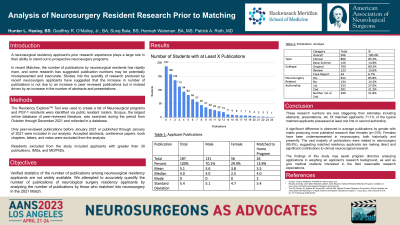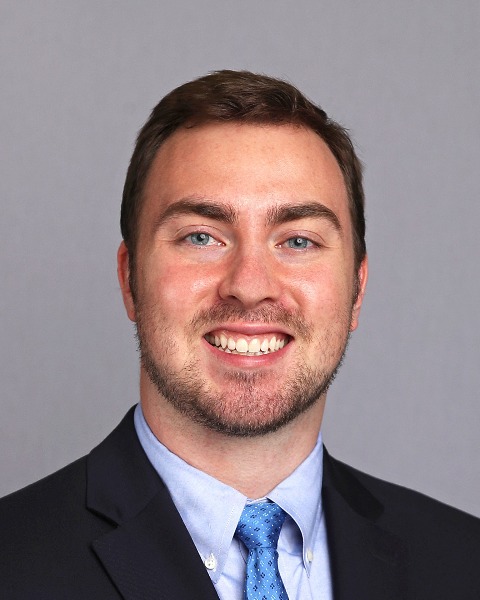Realistic Assessment of Research Publications by Neurosurgery Residency Applicants
Friday, April 21, 2023


Hunter L. Hasley, BS
Medical Student
Hackensack Meridian School of Medicine
Nutley, New Jersey, United States
ePoster Presenter(s)
Introduction: A neurosurgical residency applicant’s prior research experience can amplify their ability to stand out to prospective neurosurgery programs. We attempted to accurately quantify the number of research publications coauthored by applicants by analyzing the publications of those who matched into neurosurgery in the 2021 Match.
Methods: Scopus, a peer-reviewed literature database, was queried for publications by those who matched into neurosurgery in the 2021 Match prior to the finalization of rank lists. Conference papers, abstracts, and book chapters were excluded to determine an accurate average of actual publications. Residents with over 30 publications otherwise meeting criteria for the study in Scopus were removed from the analysis to identify typical applicants. Descriptive statistics for resident publication data were utilized, with a Mann-Whitney U test used to compare research productivity between male and female residents.
Results: There were 234 positions filled by the 2021 NRMP match, and 233 neurosurgical residents were identifiable in this study. 187 residents matching from US MD and DO programs were characterized as typical applicants with 946 total publications, an average of 5.1 publications per resident. These publications include 80.3% original research publications, 13.0% systematic reviews, and the remaining 6.7% as case reports. This study recognized 85.2% of publications as clinical research with the remaining 14.7% classified as basic science. 84.5% of typical matched applicants were coauthors on at least one publication, and 71.1% of the typical matched applicants were first or second authors on a publication. Significant differences were found in the number of publications between male and female applicants with averages of 5.6 and 3.8 publications, respectively.
Conclusion : Students matriculating to neurosurgery residency programs display a wide range of research productivity. This information may assist program directors in weighing an applicant’s research background and give medical students interested in the field reasonable research expectations.
Methods: Scopus, a peer-reviewed literature database, was queried for publications by those who matched into neurosurgery in the 2021 Match prior to the finalization of rank lists. Conference papers, abstracts, and book chapters were excluded to determine an accurate average of actual publications. Residents with over 30 publications otherwise meeting criteria for the study in Scopus were removed from the analysis to identify typical applicants. Descriptive statistics for resident publication data were utilized, with a Mann-Whitney U test used to compare research productivity between male and female residents.
Results: There were 234 positions filled by the 2021 NRMP match, and 233 neurosurgical residents were identifiable in this study. 187 residents matching from US MD and DO programs were characterized as typical applicants with 946 total publications, an average of 5.1 publications per resident. These publications include 80.3% original research publications, 13.0% systematic reviews, and the remaining 6.7% as case reports. This study recognized 85.2% of publications as clinical research with the remaining 14.7% classified as basic science. 84.5% of typical matched applicants were coauthors on at least one publication, and 71.1% of the typical matched applicants were first or second authors on a publication. Significant differences were found in the number of publications between male and female applicants with averages of 5.6 and 3.8 publications, respectively.
Conclusion : Students matriculating to neurosurgery residency programs display a wide range of research productivity. This information may assist program directors in weighing an applicant’s research background and give medical students interested in the field reasonable research expectations.
